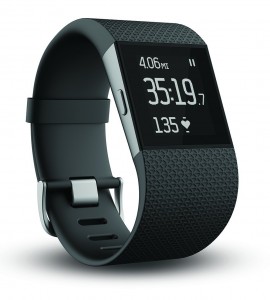I’m not one to make New Year’s resolutions. What, I ask, is any different about the start of a new year than the start of a new month, week, day, quarter – I guess it’s a traditional milestone.
But since I’m now living in-city and walking far, far more than I ever did previously, and every day, I figured that I’d take a stab at tracking my activity. My employer, as part of our wellness program (every employer has these things now don’t they…) has partnered with Krowdfit to incentivize participation, and I chose to use a Fitbit Surge device to track my activity.
As I’m still quite new to this device, I’m still getting used to how it works and generally living with it. But like most tech that I choose to use, I picked this device because for me it has some basic conveniences that make it simple and easy to use – so it actually GETS used. The main reason I picked this particular unit is that is has a decent looking watch face as its primary display. It also seamlessly syncs with its app on my Android phone, which then silently syncs to the online dashboard. If I chose to activate GPS to better track a long walk or the like, it’s easy to do, but not necessary as its basic function tracks steps, stairs climbed, etc. without needing GPS.
I haven’t yet determined how accurate it is tracking steps, but it seems pretty close. A lot more accurate than the tracker in my phone, which is dependent on the phone actually being in my pocket, of course – and it’s amazing how often I forget the thing on my desk during the day. Having this thing strapped to my wrist makes it much more difficult to inadvertently set down someplace. I know from earlier attempts at tracking my steps with a traditional pedometer, that in my daily work on a reasonably busy day, it’s not that hard for me to get past 10,000 steps. So far, it seems like the Surge is tracking very closely to what I’d expect.
An interesting feature is the ability to track sleep. If you’re willing to wear the thing to bed (and it took me a few nights to get used to having it on all night) it does really a pretty good job of figuring out when you fell asleep, when you were restless during the night and when you woke up. It’s been confirming just how little continuous sleep I am getting right now with my various broken bones making it uncomfortable to stay in bed for long periods. I didn’t need a device to tell me that, but hey, I suppose it’s good to know. At least it’ll be interesting to see how this changes over time as I heal up.
My main issue at this point is remembering to charge the darned thing on a regular basis. It runs for a very long time on a charge (as long as you’re not using GPS or “always connected” mode) but that’s kind of part of the problem. It easily goes for 5-6 days without needing a charge, so it’s really easy to forget to plug it in every now and then. It has a good low battery warning, though, so thus far, I’ve yet to have it go dead on me.
We’ll see how it goes as I continue to walk in to 2016.

The significant bit about last 5-6 days relates to old tower clocks. Nearly all of the old clocks in town squares and churches were “8 day clocks”. This was because the local resident responsible for winding the clock would do it once each week on Sunday – often as part of the pre or post church routine.
A device which lasts more than two days on a charge really needs to last 8. You either get in the habit of charging it daily or weekly.
One of these weeks, I’ll let the thing run to discharge and see how long it actually lasts. The last time the “low batt” indication went off, it was almost a full 24 hours more before I remembered to plug in the charge cable and it was still running.